
The Motorola 68060 ("sixty-eight-oh-sixty") is a 32-bit microprocessor from Motorola released in April 1994. It is the successor to the Motorola 68040 and is the highest performing member of the 68000 series. Two derivatives were produced, the 68LC060 and the 68EC060.

The Motorola MC68010 and Motorola MC68012 are 16/32-bit microprocessors from Motorola, released in 1982 as successors to the Motorola 68000. The 68010 and 68012 added virtualization features, optimized loops and fixed several small flaws to the 68000. The MC68010 variants were pin compatible with its predecessor while the MC68012 is an 84-pin PGA version with its directly accessible memory space extended to 2 GiB.
DNIX is a discontinued Unix-like real-time operating system from the Swedish company Dataindustrier AB (DIAB). A version named ABCenix was developed for the ABC 1600 computer from Luxor. Daisy Systems also had a system named Daisy DNIX on some of their computer-aided design (CAD) workstations. It was unrelated to DIAB's product.

The Amiga 2000 (A2000) is a personal computer released by Commodore in March 1987. It was introduced as a "big box" expandable variant of the Amiga 1000 but quickly redesigned to share most of its electronic components with the contemporary Amiga 500 for cost reduction. Expansion capabilities include two 3.5" drive bays and one 5.25" bay that could be used by a 5.25" floppy drive, a hard drive, or CD-ROM once they became available.
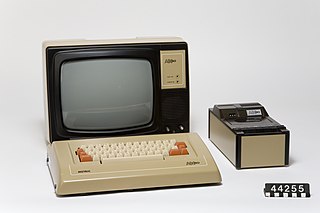
The ABC 80 was a personal computer engineered by the Swedish corporation Dataindustrier AB (DIAB) and manufactured by Luxor in Motala, Sweden in the late 1970s and early 1980s. It was introduced on the market in August 1978.
Apollo/Domain is a series of workstations that were developed and produced by Apollo Computer from c. 1980 to 1989. The machines were built around the Motorola 68k series of processors, except for the DN10000, which has from one to four of Apollo's RISC processors, named PRISM.

Amiga Unix is a discontinued full port of AT&T Unix System V Release 4 operating system developed by Commodore-Amiga, Inc. in 1990 for the Amiga computer family as an alternative to AmigaOS, which shipped by default.

The Macintosh II is a family of personal computers that was designed, manufactured and sold by Apple Computer, Inc. from 1987 to 1993. The Macintosh II was the initial model, representing the high-end of the Macintosh line for the time. Over the course of the next six years, seven more models were produced, culminating with the short-lived Macintosh IIvi and Macintosh IIvx models. Apple retired the Macintosh II name when it moved to Motorola 68040 processors; the Centris and Quadra names were used instead.

The Atari Falcon030, released in 1992, is the final personal computer from Atari Corporation. A high-end model of the Atari ST line, the machine is based on a Motorola 68030 CPU and a Motorola 56001 digital signal processor, which distinguishes it from most other microcomputers of the era. It includes a new VIDEL programmable graphics system which greatly improves graphics capabilities.
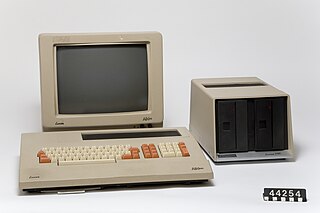
The Luxor ABC 800 series are office versions of the ABC 80 home computer. They featured an enhanced BASIC interpreter, a slightly faster clocked CPU and more memory: 32 kilobytes RAM and 32 KB ROM was now standard, the Z80 is clocked at 3 MHz. It featured 40×24 text mode with eight colors or 80×24 text mode monochrome. They could also be extended with "high" resolution graphics using 16 KB RAM as video memory.
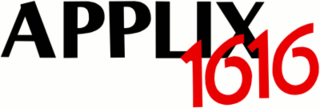
The Applix 1616 was a kit computer with a Motorola 68000 CPU, produced by a small company called Applix in Sydney, Australia, from 1986 to the early 1990s. It ran a custom multitasking multiuser operating system that was resident in ROM. A version of Minix was also ported to the 1616, as was the MGR Window System. Andrew Morton, designer of the 1616 and one of the founders of Applix, later became the maintainer of the 2.6 version of the Linux kernel.
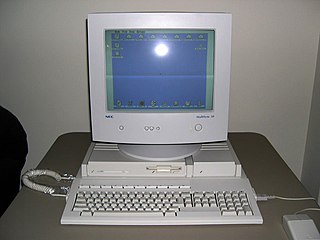
The Atari TT030 is a member of the Atari ST family, released in 1990. It was originally intended to be a high-end Unix workstation, but Atari took two years to release a port of Unix SVR4 for the TT, which prevented the TT from ever being seriously considered in its intended market.
The Acorn Business Computer (ABC) was a series of microcomputers announced at the end of 1983 by the British company Acorn Computers. The series of eight computers was aimed at the business, research and further education markets. Demonstrated at the Personal Computer World Show in September 1984, having been under development for "about a year" and having been undergoing field trials from May 1984, the range "understandably attracted a great deal of attention" and was favourably received by some commentators. The official launch of the range was scheduled for January 1985.

The PowerBook Duo 230 is a subnotebook personal computer introduced on October 19, 1992 by Apple Computer, Inc. Priced at US $2,610, the PowerBook Duo 230 was the high end model of the two simultaneously released PowerBook Duos, the lower end being the US $2,250 PowerBook Duo 210. With a 33 MHz Motorola 68030 microprocessor, 4 MB of RAM and an 80 or 120 MB SCSI hard disk drive, the PowerBook Duo 230 was nearly identical to the simultaneously released PowerBook 180 except for the smaller 9.1 inch greyscale "supertwist" passive-matrix LCD and the lack of a 68882 floating-point unit.
Torch Computers Ltd was a computer hardware company with origins in a 1982 joint venture between Acorn Computers and Climar Group that led to the development of the Communicator or C-series computer, a system based on the BBC Micro with a Z80 second processor and integral modem, intended as a viewdata terminal.
Cromemco, Inc. was a Mountain View, California microcomputer company known for its high-end Z80-based S-100 bus computers and peripherals in the early days of the personal computer revolution.
The Torch Triple X was a UNIX workstation computer produced by the British company Torch Computers, and launched in 1985. It was based on the Motorola 68010 microprocessor and ran a version of UNIX System V.

Altos Computer Systems was founded in 1977 by David G. Jackson and Roger William Vass Sr. It focused on small multi-user computers, starting with multi-user derivatives of CP/M, and later including Unix and Xenix-based machines. In its 1982 initial public offering on NASDAQ, the company raised $59M. Thereafter the company's stock was traded under the symbol ALTO.
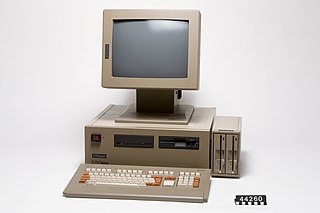
The ABC 1600 was a personal computer from Luxor that was introduced in 1985. It was built around the Motorola 68008 processor, had 1 megabyte of memory and used the operating system ABCenix, a Unix-like system developed from DNIX.

The Dimension 68000 is a microcomputer introduced by the Micro Craft Corporation in 1983 that sought to emulate the Apple II, the IBM PC, and various CP/M-centric computers through a family of coprocessor expansion cards and emulation software. The Dimension 68000 can also run as a standalone computer based on the Motorola 68000 from which it gets its namesake. The computer is mostly the brainchild of Mike Carpenter, a former executive of a scientific instrument manufacturer who incorporated Micro Craft in Dallas, Texas, to develop the Dimension 68000. It had a market lifespan of three years and received mixed, mostly positive, reception from the technology press. Criticism was leveled at the $6,250 price tag for the computer with the full deck of coprocessor cards, as well as the extent of the emulation power of those cards.















